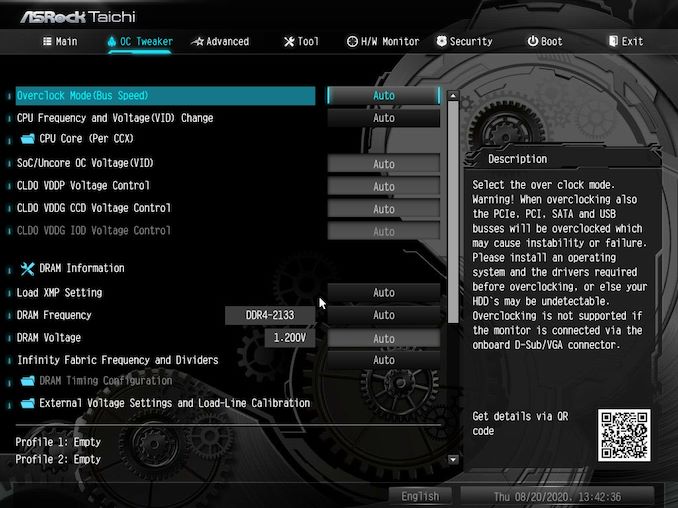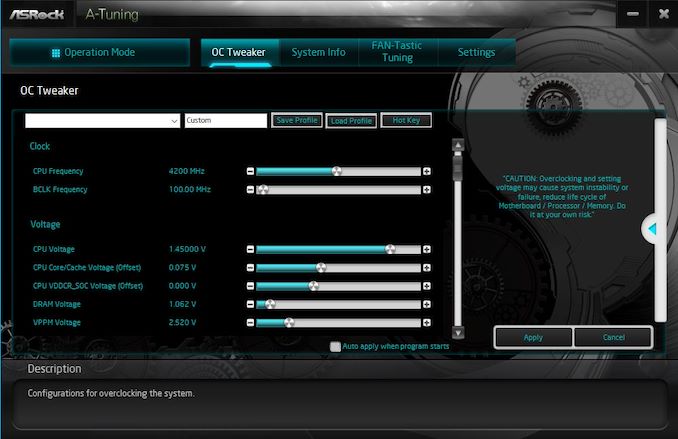ASRock B550 Taichi Review: The $300 B550 Motherboard with Chutzpah
by Gavin Bonshor on August 21, 2020 3:30 PM EST- Posted in
- Motherboards
- AMD
- ASRock
- Taichi
- AM4
- Ryzen 3000
- Ryzen 3700X
- Ryzen 4000
- B550
- B550 Taichi
BIOS
The ASRock UEFI firmware is consistent throughout its AM4 series, with the primary differences all coming in the way of simple aesthetics which is dependant on the series of motherboards. For example, the ASRock Phantom Gaming models have a black and red background, the X570 Aqua has the unique Aqua branding, while the ASRock Taichi series uses cogwheel Taichi inspired graphics. For the most part, the rest of ASRock's AM4 UEFI firmware remains the same, with minor differences coming in the settings such as controllers on Thunderbolt 3 inclusive models, and level of overclocking features which is dependent on the caliber and capability of the board.
ASRock's UEFI firmware for the B550 Taichi features an attractive GUI which is based on a black ground with Taichi inspired graphics along the bottom and right-hand side, with the different menus available to select across the top of the screen. This includes the main section which is the initial screen upon entering the firmware. The text is white, with grey boxes and a light blue highlighter to signify which option is currently selected.
The primary options for overclocking are housed within the OC Tweaker section and include all the core options for overclocking the CPU and memory. This includes options for altering the CPU ratio and BCLK frequencies, as well as adjusting the CPU core, cache voltages, and SoC voltages. For users installing X.M.P 2.0 supported memory, users can enable these by selecting the relevant profile, although ASRock includes a rather extensive selection of memory latencies for users looking to fine-tune memory for maximum performance.
Other primary menus include the Advanced section which contains all of the CPU and chipset common options which includes AMD's Precision Boost settings. The tool section includes ASRock's Polychrome RGB settings, with other useful tools coming via the firmware updater and the SSD secure-erase tool. ASRock's H/W monitor displays a list of current temperatures, voltages, and status from the onboard sensors, while users can also configure ASRock's FAN-Tastic tuning utility for optimizing fan curves. The ASRock UEFI firmware for its AM4 models is easy to navigate and offers a wide variety of options for users to tweak their system.
Software
At the core of ASRock's B550 Taichi is a software package is a flurry of useful applications and tools. At the heart of ASRock's software package is the A-Tuning software which allows users to apply overclocks to the CPU and change power settings within Windows. Other useful utilities include its Live Update and App Shop application where users can update to the latest drivers, as well as download applications, although it is riddled with Casino based games. ASRock also includes its Polychrome RGB software which allows users to customize the onboard RGB LEDs, as well as sync the lighting effects with compatible RGB memory, graphics cards, and the included RGB headers. To make use of the board's audio capabilities, ASRock also includes the Nahamic 3 software.
The ASRock A-Tuning software allows users to perform a multitude of customizations including CPU overclocking, adjusting fan curve profiles via the FAN-Tastic Tuning utility, as well as view a detailed list of system information. The main feature of the A-Tuning software comes via the OC Tweaker section which is similar to the functionality of the BIOS, but with fewer options. Users looking to overclock their CPU can use the A-Tuning to perform simple overclocks with options for CPU ratio and BCLK, with core voltage options for the CPU.
It's nice to see ASRock includes audio software in the bundle via the Nahimic 3 utility which allows users to equalize different audio aspects, and select between different preset profiles for different tasks such as gaming and movies. The ASRock Polychrome RGB software remains unchanged over previous iterations and offers plenty of visual customizations with many different lighting effects, and the ability to sync compatible components and peripherals within its RGB ecosystem.




_thumb.jpg)
_thumb.jpg)
_thumb.jpg)
_thumb.jpg)
_thumb.jpg)
_thumb.jpg)















61 Comments
View All Comments
Gigaplex - Wednesday, August 26, 2020 - link
The uncertainty certainly is annoying, but if I bought that board and then some time later had a need to install a PCIe x8 card, I'd be a bit frustrated.(I installed an LSI 9207-8i about a month ago on a motherboard I've had for >8 years, it was lucky I had an x16 slot free)
Tpoking - Saturday, August 22, 2020 - link
What's that old saying "Intel tax"? Try AMD tax only your getting less for more with this abomination and any AMD it's build over the past two months. Excuses with current event don't stick comparing the other way around. AMD is not value when considering anything but budget Matx boards and last Feb choosers.antonkochubey - Saturday, August 22, 2020 - link
Yeaaaah because Z490 boards (B550 is equivalent to Z490 - allows x8/x8 split, has PCIe 3.0, allows overclocking) can be found for $42 or for free on the side of the road /sSpunjji - Monday, August 24, 2020 - link
Great post, next time try adding some facts.Oxford Guy - Saturday, August 22, 2020 - link
Let's see...Midrange chipset at premium price, for no justifiable reason? Check.
Tons of VRM phases for CPUs that shouldn't even be overclocked? Check.
Excuses? Hmm...
antonkochubey - Sunday, August 23, 2020 - link
This midrange chipset matches Intel's highest-end chipset in it's feature set, and exceeds in some (PCIe 4.0 and CPU-direct first M.2).MrVibrato - Sunday, August 23, 2020 - link
I think it will be easier for you to use your fingers when counting PCI lanes.Spunjji - Monday, August 24, 2020 - link
The VRM thing really bugs me.lorribot - Sunday, August 23, 2020 - link
Why?Why 2.5GbE? No routers supplied by ISPs support this so yuo would need to spend a stack on a seperate switch. I am not entirely sure what the use case would be for 2.GbE and what sort of data would need to be transferred over that link. When there is also a top end WiFi 6 built in as well. One or other of these expensive features will be unused.
This board, like many of the B550 boards, makes no sense except in very few use cases, noise or heat, over an X570 based board that brings more future proofed support for PCI 4.
the top price for a B550 board should be around £/$70-100 and no more but there is massive shortage of boards in that price bracket.
A £/$75 board would give a good entry in to AM4 for those still on old Haswell/Broadwell CPUs still looking for a value upgrade path in the AMD productstack.
Gigaplex - Sunday, August 23, 2020 - link
I use 2.5GbE. Gigabit is the single biggest bottleneck for NAS speeds. I use a single SSD in my system, mass storage is on the NAS. I don't want a loud mechanical drive sitting right next to me. I also don't even have a switch, I connect the two endpoints directly.Switches aren't going to be commonly available at a low price until 2.5GbE is ubiquitous. For that to happen there's going to be a period of time where some people like you keep complaining about having faster ports with nothing to plug in to.
You want the cheap motherboards you're asking for? A520 is for you.